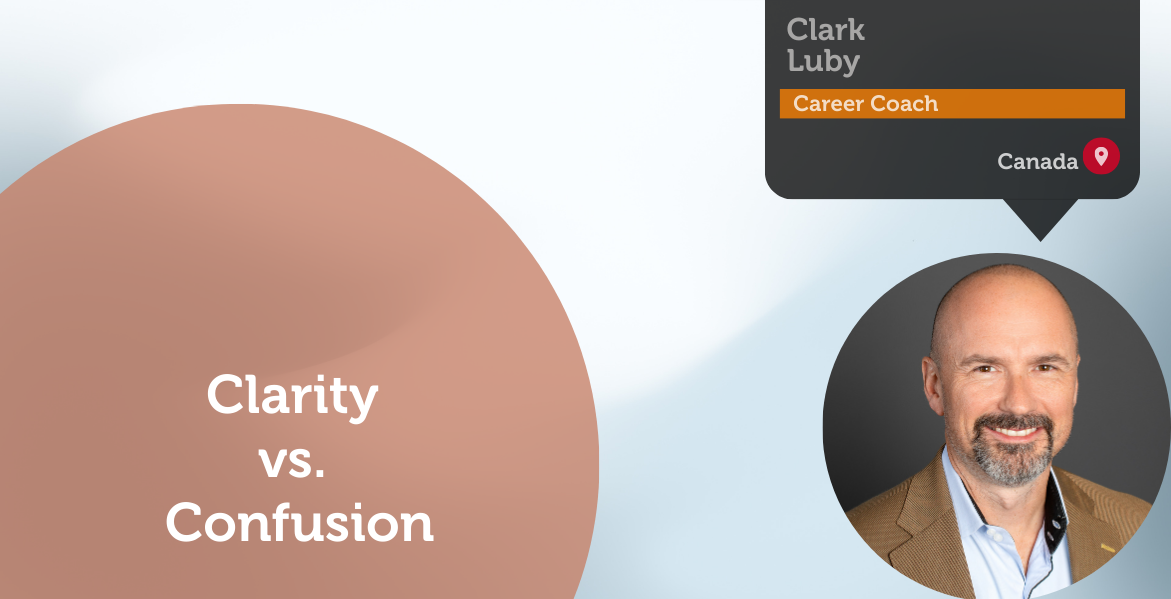A Coaching Power Tool By Clark Luby, Career Coach, CANADA


Clarity vs. Confusion
One of the most common themes I see showing up is when a client is looking for “clarity” from our coaching session. This is no doubt something that all coaches go through on a regular basis because clients are often wrestling with two areas – what they want and where to start. The wonderful thing about coaching is it affords the opportunity for the client to have the coach as a thought partner, helping them to work through these two initial areas.
Confusion arises when individuals find themselves overwhelmed with an abundance of options, information, or emotions, making it challenging to make clear decisions or see a clear path forward. It can be brought about by a variety of factors, including uncertainty, fear of failure, lack of self-awareness, and external influences. On the other hand, clarity is the state of mental focus and understanding, enabling individuals to gain insight, set clear objectives, and take purposeful actions.
What Is a Client Looking for When They Say They Want Clarity?
First, it’s important to understand what is on the opposite side of clarity. This is how we get into our discussion on the power tool.
According to Thesaurus.com, among the several words that are an antonym for clarity is confusion. However, if a client is seeking “clarity” does that mean they are confused? Not necessarily, but it could be one of the ways people feel when they lack clarity.
People all around us get “stuck.” The most common metaphor for stuck is procrastination, however, procrastination is a verb simply delaying or postponing something without actually getting into why or what that something is. Many coaching clients come to a coaching session trying to figure out that “something.”
I chose this as my flipped perspective because it’s where my passion for coaching shows the most. I love to work with clients who arrive at a coaching session without a clear direction of what they want to do and where they will start. In essence, they arrive confused and leave with a clear perspective on where they want to go. A lot of feelings will come up during a coaching session, confusion, shame, and doubt, and through the process of coaching and following the markers in the ICF framework, the beautiful power of coaching takes place to better understand how to move forward.
Two Contrasting States: Clarity vs. Confusion
Confusion and Clarity are two contrasting states that show up regularly in coaching sessions. Here are some examples.
Clarity:
- Goal Setting: Clarity is vital when setting specific and achievable goals. A skilled coach helps clients gain clarity about what they want to achieve, ensuring that the objectives are well-defined and aligned with their values and aspirations.
- Self-Discovery: Coaches often facilitate self-exploration exercises and discussions that lead to greater self-awareness and understanding. Clients gain clarity about their strengths, weaknesses, beliefs, and motivations, which can be transformational in guiding their life decisions.
- Action Planning: Clarity enables clients to develop concrete action plans to achieve their goals. With a clear roadmap, they can make steady progress and stay focused on their objectives. A coach assists clients in setting clear and realistic goals aligned with their values and aspirations. By breaking these goals into actionable steps, the life coach provides a structured roadmap that guides individuals toward their desired outcomes. This organized approach minimizes confusion and creates a sense of direction and purpose.
- Overcoming Obstacles: When clients face challenges or obstacles, a clear perspective allows them to identify potential solutions and move past roadblocks more effectively. Life challenges and obstacles can create confusion and self-doubt. Clients seek clarity to identify solutions, strengths, and resources to overcome these obstacles.
- Decision Making: Clients may seek a coach’s guidance when making important life decisions. Clarity helps clients make informed choices that align with their values and long-term vision.
- Accountability: Clear goals and plans make it easier for the life coach to hold clients accountable for their actions and progress, fostering commitment and responsibility.
Confusion:
- Lack of Direction: Confusion may arise when clients are uncertain about their goals or unsure about what they want to achieve in their personal or professional lives.
- Overwhelm: Sometimes clients feel overwhelmed by the multitude of options or challenges they face. They may struggle to identify the best course of action due to a lack of clarity.
- Self-Doubt: Confusion can lead to self-doubt and a lack of confidence in decision-making. Clients may question their abilities and become paralyzed by indecision.
- Ineffective Strategies: A confused client may attempt various approaches without clearly understanding how they align with their goals, leading to wasted time and energy.
- Emotional Blocks: Unresolved emotions can create confusion and prevent clients from moving forward. A life coach may need to help clients process these emotions to restore clarity.
- Lack of Progress: When clients lack clarity, their progress can be slow or stagnant. This can lead to frustration and a feeling of being stuck in life.
During a coaching session, coaches engage in active listening, asking powerful questions, reframing perspectives, and exploring options to help clients gain the clarity they are looking for. None of this can happen however with a goal for the session defined first. Once this has been done, the session can take place and conclude with options examined, action planning, accountability and support all while addressing fears and any limiting beliefs.
The flip-it perspective can be a very powerful tool to use with clients. Having clients examine what confusion looks and feels like with what clarity looks and feels like is part of the process. As coaches, we have the ICF framework to help guide them in a way they likely never be able to do on their own. We take an unbiased approach, free of the distraction of knowing the individual as a family member, long-time friend, or colleague.
Consider this power tool the next time you are coaching a client, and discover how this flipped perspective can help your clients get the most from a coaching session.